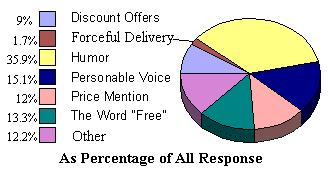| Tuesday, May 27, 2014 |  |
 |
 |
|
Hear Today's Songs |
 |
 
 
 |
 |


 A New Breed of Indie Artists
A New Breed of Indie Artists Free Music and Programs for Radio and Podasters
Free Music and Programs for Radio and PodastersOnline Radio Needs PPA Advertising
|
There have been more than a few articles on ads, within radio industry trades recently. Just today Radio Ink features one from former Katz Marketing Solutions President, Bob McCurdy: "Creative Fundamentals That Generate Results." I have written, produced, or acted as talent in well over 10,000 radio and television commercials, which is a track record that allows me to comment. Nearly all of what Bob says is fact. Though, what follows outlines the problems in these words. |
"Let's be frank; you have sales people writing copy and handing it over to production directors who are responsible for imaging and doing commercials for 4-6 stations." |
There seems to be a lot said about radio advertising. If published by the radio industry, it's good. If coming from advertisers, agencies, or veteran producers of commercials, it's not so good.
To start, let's pull a 2004 quote from Gary Fries, former RAB CEO, on the first Radio Lab Effectiveness Study titled "How Radio Ads Affect Consumers": "I was surprised at the clarity of what the message [of the study] is. What's most important is that there's no room for generic radio commercials. To be effective at generating ROI, they [radio commercials] have to touch the consumer."
After the second study in 2005, Mr. Fries said: "The results of the study expose a striking difference between what we think and what our clients think." (Here is the "Radio Industry Media Accountability Study" presented at RAB2005.)
I think it's fair to say that Gary Fries appears to not have a grasp on the revenue generation portion of this industry.
Now let's look at how much effort has been put forth to improve radio and/or it's advertising. All are dead or dying:
 LMiV
LMiV Network Radio Compliance Council
Network Radio Compliance Council Radio Communicators Group
Radio Communicators Group Radio 2020
Radio 2020 Radio Heard Here
Radio Heard Here The HD Radio Alliance
The HD Radio Alliance Radio. You Hear It Here First
Radio. You Hear It Here First Less is More
Less is More Radio Creative Resource Group
Radio Creative Resource Group Format Lab
Format Lab TotalRadius
TotalRadius HD Radio University
HD Radio University WhyRadio?
WhyRadio? Blink Ads
Blink Ads The International Broadcasters IdeaBank
The International Broadcasters IdeaBankAre you beginning to think that maybe this whole concept of "improving radio ads" is a cyclic motion that means little to anyone who oversees the radio industry? I got that feeling a long time ago, and it was reinforced when radio could not create an effective way to sell HD Radio to the public. This multi-year campaign was one bad creative concept after another, kept weak by poor production; these two elements are pointing to why the online radio industry desperately needs to avoid what the broadcast radio industry does with its commercials, and offer Pay-Per-Action ads as its standard.
I fought the PPA format for years, back in the early 2000s. Said it was going to lower CPM, which it did. Also said it put the onus of response on the media, which is why agencies love to invest in running PPA. Why not get all those extra impressions and only pay when someone responds?
I converted over a dozen years ago and started to digest exactly what it was that radio could do with a Pay-Per-Action campaign.
First, face the fact that no matter how many people call for quality creative in radio, nobody expects it. Let's be frank; you have sales people writing copy and handing it over to production directors who are responsible for imaging and doing commercials for 4-6 stations. There simply is not enough time to experiment in the production process - and it's this "time" which produces quality radio commercials.
Anyone who believes that writing "compelling" copy is easy, or that it can be done in one draft over twenty minutes, should be removed from the writing process. My average time spent in writing an ad is 3-5 hours; that includes the research and 8-10 rewrites. Then it's off to the production room where another few hours can easily be spent fine-tuning delivery, while choosing music and - if needed - sound effects (example ad). And this is a strong reason why, online, the radio industry should begin featuring Pay-Per-Action ads. Want a reinforcement on that reason? It also lets you track and provide response factors to the client, and allows changes to be made during the campaign to improve response.
Now that we have such a wide selection of stations online, this radio industry must avoid offering to clients what its broadcast cousins are failing so miserably at - advertising that doesn't work.
It's not the creative. You don't have time to do quality creative for even a small portion of radio commercials.
It's not the production. Production directors are saddled with far too many stations to produce quality in the scale needed.
It's not having sales people write scripts. Script writing is an arduous process, and it requires someone skilled in words, marketing, and conceptualizing a fresh approach.
|
This appeared at Audio Graphics September 13, 2004. It's still applies today. Consumers are fairly easy to read. They'll even give you directions if you ask them, as we did in an RRadio Network survey. "What in a radio ad is most likely to get your attention?" was the question. The answers, provided by over 2,000 listeners of radio online, were:  Look closely at the response. The lowest scoring categories are those that are most used in radio advertising today [still]. |
Pay-Per-Action is a straight forward method of paying for a radio ad that the radio industry has too long neglected to improve. It allows radio to continue its down-and-dirty approach to "just get it on the air" that's become a lexicon in radio. And it lets the online radio industry offer advertisers something different: fact-based ROI.
Download a spreadsheet that helps determine what you need to charge in a PPA campaign to keep your rates in-line with a desired CPM rate.
More Articles
Today's indie introduction is to...
| Pop artist Carmin Blinn |
 sample song |
I Wish Download Song
|
Give Carmin Blinn's "I Wish" a listen.
Add it to your playlist, free!
 |
 |
 |
comments by Disqus |



